Volume 7 | Number 1 | May 2015
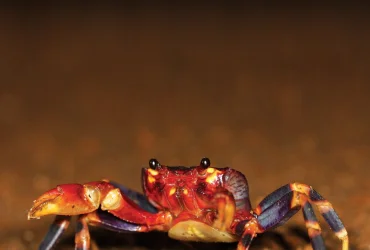 v7i1.148
v7i1.148ISSN: 1800-427X (print)
eISSN: 1800-427X (online)
DOI:10.47605/tapro.v7i1.148
Submitted date: 1 October 2014
Accepted date: 20 November 2014
Published date: 19 January 2015
Pp. 1–7, Pl. 1–3.
A NEW MONTANE SPECIES OF THE GENUS Pareas WAGLER, 1830 (SQUAMATA: PAREATIDAE) FROM NORTHERN MYANMAR
Gernot Vogel*
*Corresponding author. E-mail: gernot.vogel@t-online.de
Abstract
A new species of the genus Pareas is described from northern Myanmar. It differs from all other known species of the genus by coloration, which is mainly uniform, and its size (one of the largest species in the genus). Furthermore it is characterized by a low number of supralabials (six), a loreal that touches the orbit, presence of a presubocular and absence of a preocular. The new species was found at an elevation of 1890 m a.s.l. and is regarded as an inhabitant of high elevation mountainous areas.
Key words : Asia, Colubroidea, Oriental region, Pareas vindumi sp. nov., taxonomy
Section Editor: Olivier S.G. Pauwels
eISSN: 1800-427X (online)
DOI:10.47605/tapro.v7i1.148
Submitted date: 1 October 2014
Accepted date: 20 November 2014
Published date: 19 January 2015
Pp. 1–7, Pl. 1–3.
A NEW MONTANE SPECIES OF THE GENUS Pareas WAGLER, 1830 (SQUAMATA: PAREATIDAE) FROM NORTHERN MYANMAR
Gernot Vogel*
*Corresponding author. E-mail: gernot.vogel@t-online.de
Abstract
A new species of the genus Pareas is described from northern Myanmar. It differs from all other known species of the genus by coloration, which is mainly uniform, and its size (one of the largest species in the genus). Furthermore it is characterized by a low number of supralabials (six), a loreal that touches the orbit, presence of a presubocular and absence of a preocular. The new species was found at an elevation of 1890 m a.s.l. and is regarded as an inhabitant of high elevation mountainous areas.
Key words : Asia, Colubroidea, Oriental region, Pareas vindumi sp. nov., taxonomy
Section Editor: Olivier S.G. Pauwels
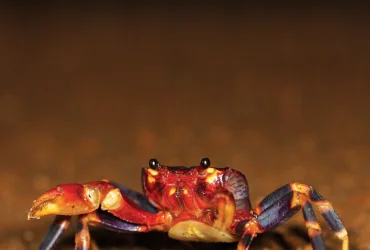 v7i1.165
v7i1.165ISSN: 1800-427X (print)
eISSN: 1800-427X (online)
DOI:10.47605/tapro.v7i1.165
Submitted date: 30 May 2014
Accepted date: 16 July 2014
Published date: 19 January 2015
Pp. 66–67. Pls. 26.
Mating behaviour of the Indian flying fox (Chiroptera) in southern Bangladesh
M.A. Baki, H. Al-Razi & S.M.I. Alam*
*Corresponding author. E-mail: shayermia@hotmail.com
Bangladesh is inhabited by 38 species of bats (Order Chiroptera) of which three are frugivorous. One of the latter is the Indian flying fox Pteropus giganteus, a common species in the country. The Indian flying fox is widely distributed in South and Southeast Asia from Pakistan to China and as far south as the Maldives Islands. Although the IUCN deems it as a species of Least Concern the population trend is decreasing.
Section Editor: Asoka Yapa
eISSN: 1800-427X (online)
DOI:10.47605/tapro.v7i1.165
Submitted date: 30 May 2014
Accepted date: 16 July 2014
Published date: 19 January 2015
Pp. 66–67. Pls. 26.
Mating behaviour of the Indian flying fox (Chiroptera) in southern Bangladesh
M.A. Baki, H. Al-Razi & S.M.I. Alam*
*Corresponding author. E-mail: shayermia@hotmail.com
Bangladesh is inhabited by 38 species of bats (Order Chiroptera) of which three are frugivorous. One of the latter is the Indian flying fox Pteropus giganteus, a common species in the country. The Indian flying fox is widely distributed in South and Southeast Asia from Pakistan to China and as far south as the Maldives Islands. Although the IUCN deems it as a species of Least Concern the population trend is decreasing.
Section Editor: Asoka Yapa
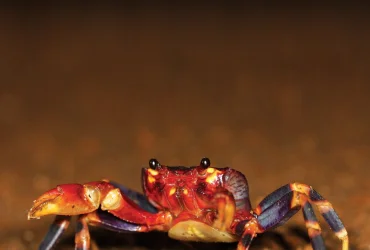 v7i1.164
v7i1.164ISSN: 1800-427X (print)
eISSN: 1800-427X (online)
DOI:10.47605/tapro.v7i1.164
Submitted date: 30 May 2014
Accepted date: 16 July 2014
Published date: 19 January 2015
Pp. 62–65. Pls. 24–25.
Habitat comparison of Cynopterus fruit bats at Lampung, Sumatra, Indonesia
J. Ramadhan & N.L. Winarni
*Corresponding author. E-mail: n.winarni@gmail.com
Indonesia is home to at least 205 species of bats, over a fifth of the world's total. Chiroptera in the Indonesian island chain belong to nine families and 52 genera. Most of these bats are insectivores but the Pteropodidae of sub-Order Yinpterochiroptera are frugivores and nectarivores and, hence, important pollinators of economically significant plants such as petai (Parkia speciosa), durian (Durio zibethinus), mango (Mangifera indica), and kapok (Ceiba pentandra); they also disperse seeds of water apple (Syzygium aqueum), guava (Psidium guajava), and canarium nut (Canarium sp.). Not only do these pteropodid bats play roles in agriculture and ecosystem continuity, they also figure in the reproductive success of plants and in the regeneration of disturbed areas.
Section Editor: Asoka Yapa
eISSN: 1800-427X (online)
DOI:10.47605/tapro.v7i1.164
Submitted date: 30 May 2014
Accepted date: 16 July 2014
Published date: 19 January 2015
Pp. 62–65. Pls. 24–25.
Habitat comparison of Cynopterus fruit bats at Lampung, Sumatra, Indonesia
J. Ramadhan & N.L. Winarni
*Corresponding author. E-mail: n.winarni@gmail.com
Indonesia is home to at least 205 species of bats, over a fifth of the world's total. Chiroptera in the Indonesian island chain belong to nine families and 52 genera. Most of these bats are insectivores but the Pteropodidae of sub-Order Yinpterochiroptera are frugivores and nectarivores and, hence, important pollinators of economically significant plants such as petai (Parkia speciosa), durian (Durio zibethinus), mango (Mangifera indica), and kapok (Ceiba pentandra); they also disperse seeds of water apple (Syzygium aqueum), guava (Psidium guajava), and canarium nut (Canarium sp.). Not only do these pteropodid bats play roles in agriculture and ecosystem continuity, they also figure in the reproductive success of plants and in the regeneration of disturbed areas.
Section Editor: Asoka Yapa
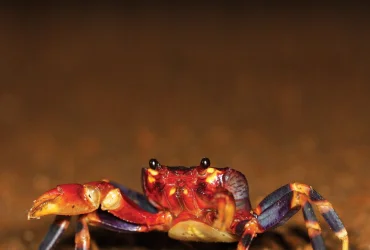 v7i1.163
v7i1.163ISSN: 1800-427X (print)
eISSN: 1800-427X (online)
DOI:10.47605/tapro.v7i1.163
Submitted date: 7 July 2014
Accepted date: 24 July 2014
Published date: 19 January 2015
Pp. 60–61.
On latex licking in the five-striped palm squirrel (Funambulus pennantii)
S.K. Sharma* & V.K. Koli
*Corresponding author. E-mail: sksharma56@gmail.com
The five-striped palm squirrel, Funambulus pennantii and three-striped palm squirrel, F. palmarum, consume liquid food in the form of nectar and latex in addition to solid food. The latexy secretion from the abaxial surface of the leaves at the junction of petiole and lamina of the leaves of the Banyan, Ficus benghalensis (Moraceae) is licked by both F. pennantii and F. palmarum as food. A scar is seen on the licked site of every leaf which appears to be a result of repeated licking and drying of the residue of the secretion.
Section Editor: Colin P. Groves
eISSN: 1800-427X (online)
DOI:10.47605/tapro.v7i1.163
Submitted date: 7 July 2014
Accepted date: 24 July 2014
Published date: 19 January 2015
Pp. 60–61.
On latex licking in the five-striped palm squirrel (Funambulus pennantii)
S.K. Sharma* & V.K. Koli
*Corresponding author. E-mail: sksharma56@gmail.com
The five-striped palm squirrel, Funambulus pennantii and three-striped palm squirrel, F. palmarum, consume liquid food in the form of nectar and latex in addition to solid food. The latexy secretion from the abaxial surface of the leaves at the junction of petiole and lamina of the leaves of the Banyan, Ficus benghalensis (Moraceae) is licked by both F. pennantii and F. palmarum as food. A scar is seen on the licked site of every leaf which appears to be a result of repeated licking and drying of the residue of the secretion.
Section Editor: Colin P. Groves
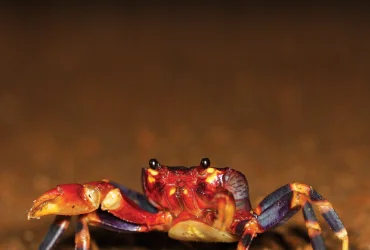 v7i1.162
v7i1.162ISSN: 1800-427X (print)
eISSN: 1800-427X (online)
DOI:10.47605/tapro.v7i1.162
Submitted date: 14 May 2014
Accepted date: 20 July 2014
Published date: 19 January 2015
Pp. 57–59, Pl. 23.
On the mating behaviour of captive Indian pangolin (Manis crassicaudata)
R.K. Mohapatra*, S. Panda, M. V. Nair
*Corresponding author. E-mail: rajesh.wildlife@gmail.com
The Indian pangolin, Manis crassicaudata is under serious threat due to hunting for local consumption and for international trade in skins, scales and meat, and to a lesser extent, loss and deterioration of its habitat. This species is listed as ‘Endangered’ and included under Appendix II of CITES. Because of their nocturnal, burrowing and secretive nature, information on their biology in the wild is very limited. They are difficult to maintain and rarely breed in captivity. Although several zoos have maintained this species, births in captivity have been reported by very few zoos: Calcutta zoo, Oklahoma zoo, Nandankanan Zoological Park. Although earlier studies have described nocturnal behaviour and activity pattern of Indian pangolins in captivity, observations on their mating behaviour are limited mainly because mating is seldom observed. This study reports on mating behaviour observed in captivity.
Section Editor: Colin P. Groves
eISSN: 1800-427X (online)
DOI:10.47605/tapro.v7i1.162
Submitted date: 14 May 2014
Accepted date: 20 July 2014
Published date: 19 January 2015
Pp. 57–59, Pl. 23.
On the mating behaviour of captive Indian pangolin (Manis crassicaudata)
R.K. Mohapatra*, S. Panda, M. V. Nair
*Corresponding author. E-mail: rajesh.wildlife@gmail.com
The Indian pangolin, Manis crassicaudata is under serious threat due to hunting for local consumption and for international trade in skins, scales and meat, and to a lesser extent, loss and deterioration of its habitat. This species is listed as ‘Endangered’ and included under Appendix II of CITES. Because of their nocturnal, burrowing and secretive nature, information on their biology in the wild is very limited. They are difficult to maintain and rarely breed in captivity. Although several zoos have maintained this species, births in captivity have been reported by very few zoos: Calcutta zoo, Oklahoma zoo, Nandankanan Zoological Park. Although earlier studies have described nocturnal behaviour and activity pattern of Indian pangolins in captivity, observations on their mating behaviour are limited mainly because mating is seldom observed. This study reports on mating behaviour observed in captivity.
Section Editor: Colin P. Groves
Hubungi Kami
The ultimate aim of the journal is to provide an effective medium for communication of the latest and best scientific information.
Copyright © 2020 Taprobanica. All Rights Reserved
Jasa Pembuatan Website by IKT




